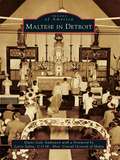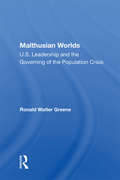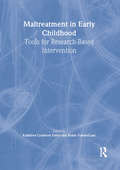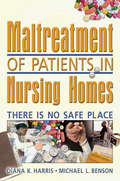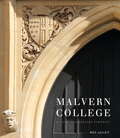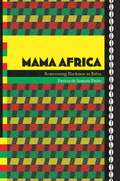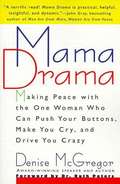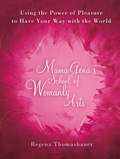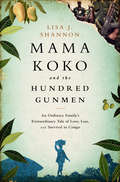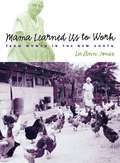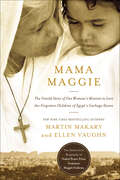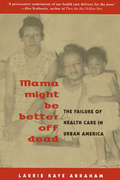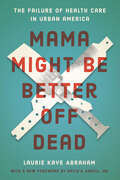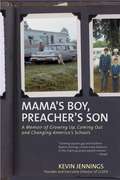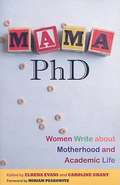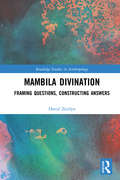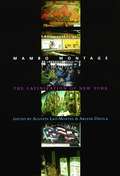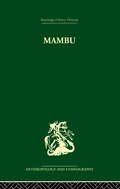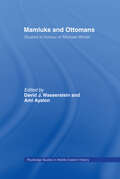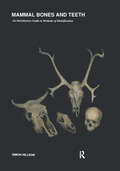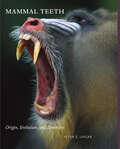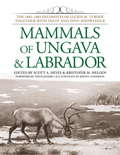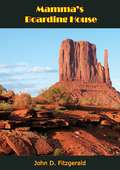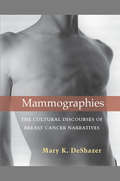- Table View
- List View
Maltese in Detroit
by Larry Zahr U.O.M. Diane Gale AndreassiMost Maltese immigrants came to the United States during the first decades of the 20th century after the discharge of skilled workers from the Royal British Dockyard in 1919 following the end of World War I. More than 1,300 Maltese came to the United States in the first quarter of 1920. Many people found work in the automobile industry, and with about 5,000 residents, Detroit had the largest Maltese population in the United States. Maltese in Detroit focuses on the many people of Maltese descent who made their homes in Detroit's Corktown area. By the mid-1920s, it is believed that more than 15,000 Maltese had settled in the United States. After World War II , the Maltese government launched a program to pay passage for Maltese willing to immigrate and remain abroad for at least two years. By the mid-1990s, an estimated more than 70,000 Maltese immigrants and descendants were living in the United States, with the largest single community in Detroit and its surrounding suburbs.
Malthusian Worlds: U.S. Leadership And The Governing Of The Population Crisis
by Ronald Walter GreeneThis book focuses on how the population crisis as a governing apparatus was assembled as a particular form of Malthusian rationality. A central argument is that U.S. leadership in governing the population crisis required both a global and local appreciation of population dynamics.
Maltreatment in Early Childhood: Tools for Research-Based Intervention
by Robin Vanderlaan Kathleen Coulborn FallerDetect and put a stop to child abuse!For mental health professionals, social workers, legal professionals, and policy makers, Maltreatment in Early Childhood: Tools for Research-Based Intervention examines strategies and ideas for professional training in child protection in the United States. Derived from presentations at the San Diego Conference Responding to Child Maltreatment, this book addresses current assessment issues, the intersection of child maltreatment and other social problems, the history of child protection, and the intricacies of courtroom testimonies, and provides guidance for case management. Through insight into research and case studies, Maltreatment in Early Childhood explores effective approaches to child-friendly services, multivictim cases, therapy, and victim recantation to help you assist sexually abused children or children who have witnessed domestic abuse.Addressing a variety of challenges that face all those involved with youth in need of assistance due to abuse, this informative book examines why children of different racial identities may display different secret-keeping behavior, and presents a variety of approaches that encourage clients to talk about their situation. Maltreatment in Early Childhood explores child abuse from a historical and political context, and discusses key issues relating to all facets of this social problem, including: understanding the pros and cons of asking children to recall their experiences through specific types of questions, such as invitational questions and less preferred questions, which may or may not reveal true answers deciding if the Validity Checklist, the second part of the Analysis procedure, is able to determine truthfulness of allegations in child sexual abuse cases testing the efficacy of the model designed at the National Children's Advocacy Center (NCAC), which may be used to validate abuse and determine if children's statements are accurate overcoming difficulties in the child protection system, including the probability of multiple interviews and potential contamination of children's narratives by a variety of sources, to produce fair evaluations and successful prosecutionsWith tables and charts that will help you easily explore research findings, Maltreatment in Early Childhood provides you with the information you need in order to determine the truth of children's statements, how to present statements in court, and how to affect changes that will protect and assist victims of childhood sexual abuse.
Maltreatment of Patients in Nursing Homes: There Is No Safe Place
by Harold G Koenig Diana Harris"Abuse, although often not detected or reported, existed in every facility we surveyed. It is a serious problem."Old, weak, and often cognitively impaired, nursing home patients can be easy targets for physical, psychological, material, and financial mistreatment at the hands of those entrusted with their care, safety, and well-being. Maltreatment of Patients in Nursing Homes: There Is No Safe Place examines the dark side of nursing homes, where not every employee has the commitment of Mother Theresa. This groundbreaking book applies criminological theory to help develop practical methods of controlling abuse and presents the results of the first and only nationwide study on the theft of patients&’ belongings, a form of abuse too often ignored by the nursing home industry. Maltreatment of Patients in Nursing Homes surveys employees, administrators, and family members of patients in 47 nursing homes throughout the United States. Their responses provide invaluable insights on a wide range of topics, including the social and psychological factors that cause different types of abuse, characteristics of nursing home patients and employees, the bureaucracy of nursing homes, victimization rates, workforce issues of nursing home aides, and federal regulations for nursing homes. The information gained from the surveys forms the basis for detailed recommendations for creating a safer environment and reducing all forms of abuse, including theft-prevention training programs, background checks and improved screening of potential employees, education and advocacy for current staff, and the reform of federal regulations.Maltreatment of Patients in Nursing Homes examines: types of physical abuse (restraints, sexual abuse, neglect) the who, what, and why of nursing home theft types of financial abuse (trust accounts, bank accounts, improper charges for services and drugs, identity theft) types of psychological abuse (abandonment, segregation, childlike treatment, verbal abuse) effects of psychological abuse (depression, learned helplessness, psychiatric disorders) reasons for abuse by employees (staff turnover, job burnout, job dissatisfaction, caregiver stress)One of the few books to deal with abuse of the elderly outside a domestic setting, Maltreatment of Patients in Nursing Homes: There Is No Safe Place interprets and analyzes abuse to provide new ways of thinking about this growing problem and new methods of preventing it from growing any more widespread.
Malvern College
by Roy Allen"I remember the 25th January very well. Theonly house finished was McDowall's (No. 1)and about fourteen of us assembled there.It had snowed all night, and in the morningwas about two feet deep and drifted againstthe bank in places five and six feet. We cutour way up with improvised shovels andfinally got to the Coll. where we found twoboys who were in lodgings with Mr. Drew,and about ten day boys. We were roughlyexamined and classed and were then given ahalf holiday, which I spent with a few more,wallowing in the snow."So the story of Malvern College began in 1865with twenty-four boys, a headmaster and sixassistant masters attempting to create a newschool in one of "the fairest parts of England."This new College history traces how that infantschool has matured into one of the country'sleading independent schools, welcomingstudents from across the world to enjoy amodern education in historical and beautifulsurroundings. The first half of the book is achronological survey showing how the schooldeveloped its own style and character and howits fortunes mirrored the drama of our nation'shistory. The remainder of the book explores aseries of themes charting how the educationalvision of the founders has evolved in teachingand learning, the arts and sport, and in religious,charitable and military service. Attention is paidto the changing social structure of the school andhow it has embraced new visions of leadership,coeducation, and the challenge of preservinginherited virtues and the essence of an Englishboarding school while preparing pupils for aglobalised world. Memories of life in the school,features on masters and pupils, the achievementof Old Malvernains and remarkable illustrationscombine to make this a fitting celebration of aunique school.
Mama Africa: Reinventing Blackness in Bahia
by Patricia de Santana PinhoOften called the "most African" part of Brazil, the northeastern state of Bahia has the country's largest Afro-descendant population and a black culture renowned for its vibrancy. In Mama Africa, Patricia de Santana Pinho examines the meanings of Africa in Bahian constructions of blackness. Combining insights from anthropology, sociology, and cultural studies, Pinho considers how Afro-Bahian cultural groups, known as blocos afro, conceive of Africanness, blackness, and themselves in relation to both. Mama Africa is a translated, updated, and expanded edition of an award-winning book published in Brazil in 2004. Central to the book, and to Bahian constructions of blackness, is what Pinho calls "the myth of Mama Africa," the idea that Africa exists as a nurturing spirit inside every black person. Pinho explores how Bahian cultural production influences and is influenced by black diasporic cultures and the idealization of Africa--to the extent that Bahia draws African American tourists wanting to learn about their heritage. Analyzing the conceptions of blackness produced by the blocos afro, she describes how Africa is re-inscribed on the body through clothes, hairstyles, and jewelry; once demeaned, blackness is reclaimed as a source of beauty and pride. Turning to the body's interior, Pinho explains that the myth of Mama Africa implies that black appearances have corresponding black essences. Musical and dance abilities are seen as naturally belonging to black people, and these traits are often believed to be transmitted by blood. Pinho argues that such essentialized ideas of blackness render black culture increasingly vulnerable to exploitation by the state and commercial interests. She contends that the myth of Mama Africa, while informing oppositional black identities, overlaps with a constraining notion of Bahianness promoted by the government and the tourist industry.
Mama Drama: Making Peace with the One Woman Who Can Push Your Buttons, Make You Cry, and Drive You Crazy
by Denise McgregorOffering concrete advice on how to heal volatile relationships with one's mother, McGregor, drawing from her own experiences and those of other women, shows why there is so much dissatisfaction in mother/daughter relationships.
Mama Gena's School of Womanly Arts: Using the Power of Pleasure to Have Your Way with the World
by Regena ThomashauerThe irrepressible founder of a hugely popular "school for goddesses" shows you how celebrating your sensuality can help you achieve your dreams. You've heard the saying "Do what you love, and the money will follow." Mama Gena takes that sentiment one step further, and exhorts women to do what they love because everything will follow -- success, romance, wealth, fulfillment. Profiled everywhere from The New York Times to The Conan O'Brien Show, relationship expert Regena Thomashauer (a.k.a. Mama Gena) urges women to learn this simple principle: self-indulgence is the key to self-empowerment. But in order to pursue pleasure, one must know pleasure. Believe it or not, most women can't pinpoint what really makes them happy. After all, are women ever taught to celebrate their appetites, whether it's for chocolate ice cream or a more entertaining sex life? In her "School of Womanly Arts," Mama Gena transforms ordinary women into glowing Sister Goddesses -- women fully in tune with the mystical, creative power of their sensuality -- and teaches them how to use their creative power to build the life they want. She explains the lost art of giving in to desires (even if it's just for a new lipstick), seeking fun and plea-sure at home and at work, and navigating the world using feminine power instead of patriarchal rules. This is pleasure boot camp, and be forewarned, the exercises are tough: assignments include flirting for fun, flexing your intuition, buying yourself presents, bragging about your accomplishments, and much more. Sister Goddesses report magical results: they get job offers, fall in love, find new possibilities and passions. Mama Gena's School of Womanly Arts will help readers across the country recognize and unleash their full feminine potential -- and have a great time doing it.
Mama Koko and the Hundred Gunmen: An Ordinary Family’s Extraordinary Tale of Love, Loss, and Survival in Congo
by Lisa J. ShannonInternational human rights activist Lisa Shannon spent many afternoons at the kitchen table having tea with her friend Francisca Thelin, who often spoke of her childhood in Congo. Thelin would conjure vivid images of lush flower gardens, fish the size of small children, and of children running barefoot through her family’s coffee plantation, gorging on fruit from the robust and plentiful mango trees. She urged Shannon to visit her family in Dungu, to get a taste of real Congo, peaceful Congo; a place so different than the conflict-ravaged places Shannon knew from her activism work. But then the nightly phone calls from Congo began: static-filled, hasty reports from Francisca’s mother, #147;Mama Koko,” of gunmen#151;Joseph Kony’s Lord’s Resistance Army#151; who had infested Dungu and began launching attacks. Night after night for a year, Mama Koko delivered the devastating news of Fransisca’s cousins, nieces, nephews, friends, and neighbors, who had been killed, abducted, burned alive on Christmas Day. In an unlikely journey, Shannon and Thelin decided to travel from Portland, Oregon to Dungu, to witness first-hand the devastation unfolding at Joseph Kony’s hands. Masquerading as Francisca’s American sister-in-law, Shannon tucked herself into Mama Koko’s raw cement living room and listened to the stories of Mama Koko and her husband, Papa Alexander#151;as well as those from dozens of other friends and neighbors (#147;Mama Koko’s War Tribunal”)#151;who lined up outside the house and waited for hours, eager to offer their testimony. In Mama Koko and the Hundred Gunmen, Shannon weaves together the family’s tragic stories of LRA encounters with tales from the family’s history: we hear of Mama Koko’s early life as a gap-toothed beauty plotting to escape her inevitable fate of wife and motherhood; Papa Alexander’s empire of wives he married because they cooked and cleaned and made good coffee; and Francisca’s childhood at the family #147;castle” and coffee plantation. These lively stories transport Shannon from the chaos of the violence around her and bring to life Fransisca’s kitchen-table stories of the peaceful Congo. Yet, as the LRA camp out on the edge of town grew, tensions inside the house reach a fever pitch and Shannon and Thelin’s friendship was fiercely tested. Shannon was forced to confront her limitations as an activist and reconcile her vision of what it means to affect meaningful change in the lives of others. Mama Koko and the Hundred Gunmen is at once an illuminating piece of storytelling and an exploration of what it means to truly make a difference. It is an exquisite testimony to the beauty of human connection and the strength of the human spirit in times of unimaginable tragedy.
Mama Learned Us to Work
by Lu Ann JonesFarm women of the twentieth-century South have been portrayed as oppressed, worn out, and isolated. Lu Ann Jones tells quite a different story in Mama Learned Us to Work. Building upon evocative oral histories, she encourages us to understand these women as consumers, producers, and agents of economic and cultural change.As consumers, farm women bargained with peddlers at their backdoors. A key business for many farm women was the "butter and egg trade--small-scale dairying and raising chickens. Their earnings provided a crucial margin of economic safety for many families during the 1920s and 1930s and offered women some independence from their men folks. These innovative women showed that poultry production paid off and laid the foundation for the agribusiness poultry industry that emerged after World War II. Jones also examines the relationships between farm women and home demonstration agents and the effect of government-sponsored rural reform. She discusses the professional culture that developed among white agents as they reconciled new and old ideas about women's roles and shows that black agents, despite prejudice, linked their clients to valuable government resources and gave new meanings to traditions of self-help, mutual aid, and racial uplift.
Mama Maggie: The Untold Story of One Woman's Mission to Love the Forgotten Children of Egypt's Garbage Slums
by Ellen Vaughn Marty MakaryThe inspiring, authorized biography of the woman who left a career in marketing to become the “Mother Teresa of Egypt.”Since 1997, Maggie Gobran and her organization Stephen’s Children have been changing lives in Cairo’s notorious zabala, or garbage slums. Her innovative, transformational work has garnered worldwide fame and multiple Nobel Prize nominations, but her full story has never been told—until now. Bestselling authors Martin Makary and Ellen Vaughn chronicle Mama Maggie’s surprising pilgrimage from privileged child to stylish businesswoman to college professor pondering God’s call to change. She answered that call by becoming the modest figure in white who daily navigates piles of stinking trash, bringing hope to the poorest of the poor. Smart and savvy, as tough as she is tender, Maggie Gobran is utterly surrendered to her mission to the “garbage people” who captured her heart. At her request, the book also spotlights the people she serves—the men, women, and children who prove every day what a little bit of help and a lot of love can do.
Mama Might Be Better Off Dead: The Failure of Health Care in Urban America
by Laurie Kaye AbrahamMama Might Be Better Off Dead is an unsettling, profound look at the human face of health care. Both disturbing and illuminating, it immerses readers in the lives of four generations of a poor, African-American family beset with the devastating illnesses that are all too common in America's inner-cities. The story takes place in North Lawndale, a neighborhood that lies in the shadows of Chicago's Loop. Although surrounded by some of the city's finest medical facilities, North Lawndale is one of the sickest, most medically underserved communities in the country. Headed by Jackie Banes, who oversees the care of a diabetic grandmother, a husband on kidney dialysis, an ailing father, and three children, the Banes family contends with countless medical crises. From visits to emergency rooms and dialysis units, to trials with home care, to struggles for Medicaid eligibility, Abraham chronicles their access (or lack of access) to medical care. Told sympathetically but without sentimentality, their story reveals an inadequate health care system that is further undermined by the direct and indirect effects of poverty. When people are poor, they become sick easily. When people are sick, their families quickly become poorer. Embedded in the family narrative is a lucid analysis of the gaps, inconsistencies, and inequalities the poor face when they seek health care. This book reveals what health care policies crafted in Washington, D. C. or state capitals look like when they hit the street. It shows how Medicaid and Medicare work and don't work, the Catch-22s of hospital financing in the inner city, the racial politics of organ transplants, the failure of childhood immunization programs, the vexed issues of individual responsibility and institutional paternalism. One observer puts it this way: "Show me the poor woman who finds a way to get everything she's entitled to in the system, and I'll show you a woman who could run General Motors." Abraham deftly weaves these themes together to make a persuasive case for health care reform while unflinchingly presenting the complexities that will make true reform as difficult as it is necessary. Mama Might Be Better Off Dead is a book with the power to change the way health care is understood in America. For those seeking to learn what our current system of health care promises and what it delivers, it offers a place for the debate to begin.
Mama Might Be Better Off Dead: The Failure of Health Care in Urban America
by Laurie Kaye Abraham“A provocative examination of our health care delivery for the poor. . . . Such an honest and candid account is essential.” —Alex Kotlowitz, national bestselling author of There Are No Children HereMama Might Be Better Off Dead immerses readers in the lives of four generations of a poor, African-American family from North Lawndale, Chicago, who are beset with the devastating illnesses that are all too common in America’s inner-cities. Headed by Jackie Banes, who oversees the care of a diabetic grandmother, a husband on kidney dialysis, an ailing father, and three children, the Banes family contends with countless medical crises. From visits to emergency rooms and dialysis units, to trials with home care, to struggles for Medicaid eligibility, Laurie Kaye Abraham chronicles their access—or lack thereof—to medical care. Their story reveals an inadequate health care system that is further undermined by the effects of poverty.Mama Might Be Better Off Dead is an unsettling, profound look at the human face of health care in America. This new edition includes an incisive foreword by David Ansell, a physician who worked at Mt. Sinai Hospital, where much of the Banes family’s narrative unfolds.“Goes to the heart of today’s problem. Powerful . . . deeply searching.” —Washington Post“A powerful indictment of the big business of medicine.” —Los Angeles Times“Abraham . . . illuminates the problems with passion and skill.” —Kirkus Reviews“This personally observed, lucid chronicle and call for reform of our ailing health system covers all levels of responsibility in the medical establishment.” —Publishers Weekly“Clearly identifies in human and policy terms how [healthcare] programs have failed a population desperately in need of help.” —Library Journal
Mama's Boy, Preacher's Son: A Memoir of Growing Up, Coming Out, and Changing America's Schools
by Kevin JenningsGrowing up poor in the South, Kevin Jennings learned a lot of things, especially about how to be a real man. When his father, a fundamentalist preacher, dropped dead at his son's eighth birthday party, Kevin already knew he wasn't supposed to cry. He also knew there was no salvation for homosexuals, who weren't "real men"--or Christians, for that matter. But Jennings found his salvation in school, inspired by his mother. Self-taught, from Appalachia, her formal education had ended in sixth grade, but she was determined that her son would be the first member of their extended family to go to college, even if it meant going North. Kevin, propelled by her dream, found a world beyond poverty. He earned a scholarship to Harvard and there learned not only about history and literature, but also that it was possible to live openly as a gay man. But when Jennings discovered his vocation as a teacher and returned to high school to teach, he was forced back into the closet. He saw countless teachers and students struggling with their sexual orientation and desperately trying to hide their identity. For Jennings, coming out the second time was more complicated and much more important than the first--because this time he was leading a movement for justice. Mama's Boy, Preacher's Son is that rare memoir that is both a riveting personal story and an inside account of a critical chapter in our recent history. Creating safe schools for teenagers is now a central part of the progressive agenda in American education. Like Paul Monette's landmark Becoming a Man, Dorothy Allison's Bastard Out of Carolina, and Rick Bragg's All Over but the Shoutin', Kevin Jennings's poignant, razor-sharp memoirwill change the way we see our contemporary world.
Mama, PhD: Women Write about Motherhood and Academic Life
by Elrena Evans Caroline GrantEvery year, American universities publish glowing reports stating their commitment to diversity, often showing statistics of female hires as proof of success. Yet, academic life remains overwhelmingly a man's world and the presence of women, specifically those with children, in the ranks of tenured faculty has not increased in a generation. This anthology explores the continued inequality of the sexes in higher education and suggests changes that could make universities more family-friendly workplaces. Candid, provocative, and sometimes with a wry sense of humor, the essays speak to and offer support for any woman attempting to combine work and family.
Mama’s Boy: Momism and Homophobia in Postwar American Culture
by Roel van den OeverIn postwar America, the discourse of Momism advanced the idea that an over-affectionate or too-distant mother hampers the social and psychosexual development of her children, in particular her sons. Deemed worst of all was the outcome of homosexuality, since the period saw an intense policing of sexual deviance. van den Oever zooms in on four instances of the cultural representation of Momism: The Grotto, by Grace Zaring Stone, Suddenly Last Summer, by Tennessee Williams, Alfred Hitchcock's Psycho, and Portnoy's Complaint, by Philip Roth, to offer new commentary on canonical texts, a particular moment in American culture, and future reading strategies.
Mambila Divination: Framing Questions, Constructing Answers (Routledge Studies in Anthropology)
by David ZeitlynThis book offers a major contribution to the study and analysis of divination, based on continuing fieldwork with the Mambila in Cameroon. It seeks to return attention to the details of divinatory practice, using the questions asked and life histories to help understand the perspective of the clients rather than that of the diviners. Drawing on a corpus of more than 600 cases, David Zeitlyn reconsiders theories of divination and compares Mambila spider divination with similar systems in the area. A detailed case study is examined and analysed using conversational analytic principles. The regional comparison considers different kinds of explanation for different features of social organization, leading to a discussion of the continuing utility of moderated functionalism. The book will be of interest to area specialists and scholars concerned with religion, rationality, and decision-making from disciplines including anthropology, African studies, and philosophy.
Mambo Montage: The Latinization of New York City
by Arlene Dávila Agustín Laó-MontesNew York is the capital of mambo and a global factory of latinidad. This book covers the topic in all its multifaceted aspects, from Jim Crow baseball in the first half of the twentieth century to hip hop and ethno-racial politics, from Latinas and labor unions to advertising and Latino culture, from Cuban cuisine to the language of signs in New York City.Together the articles map out the main conceptions of Latino identity as well as the historical process of Latinization of New York. Mambo Montage is both a way of imagining latinidad and an angle of vision on the city.
Mambu: A Melanesian Millennium (Princeton Legacy Library #103)
by K. O. BurridgeMambu is the name of a native of New Guinea who led what has become known as a 'Cargo' cult. These cults, common in Melanesia, are partly religious, political and economic in nature. Participants in the cult engage in exotic rites, the purpose of which is to gain possession of European manufactured goods, such as knives, medicines, razor blades, tinned foods etc. The volume discusses why these cults occur and examines a way of life of a New Guinea people and their reactions to European penetration and achievement. First published in 1960.
Mamluks and Ottomans: Studies in Honour of Michael Winter (Routledge Studies in Middle Eastern History)
by Ami Ayalon David J. WassersteinFocusing on Near Eastern history in Mamluk and Ottoman times, this book, dedicated to Michael Winter, stresses elements of variety and continuity in the history of the Near East, an area of study which has traditionally attracted little attention from Islamists. Ranging over the period from the thirteenth to the nineteenth century, the articles in this book look at the area from Istanbul down through Syria and Palestine to Arabia, the Yemen and the Sudan. The articles demonstrate the great wealth of the materials available, in a wide variety of languages, from archival documents to manuscripts and art works, as well as inscriptions and buildings, police records and divorce documentation. The topics covered are equally as varied and include Dufism, the festival of Nabi Musa, military organisations, doctors, and charity to name but a few.
Mammal Bones and Teeth: An Introductory Guide to Methods of Identification (UCL Institute of Archaeology Publications)
by Simon HillsonThis guide is designed as an introduction to the basic methods for identifying mammal bones and teeth. It is intended to highlight for beginners the main points on which identifications can be made on the bulk of bones and teeth from a small range of common Old World mammals.
Mammal Teeth: Origin, Evolution, and Diversity
by Peter S. UngarWinner, 2010 PROSE Award for Excellence in the Biological Sciences. Professional and Scholarly Publishing division of the Association of American PublishersIn this unique book, Peter S. Ungar tells the story of mammalian teeth from their origin through their evolution to their current diversity.Mammal Teeth traces the evolutionary history of teeth, beginning with the very first mineralized vertebrate structures half a billion years ago. Ungar describes how the simple conical tooth of early vertebrates became the molars, incisors, and other forms we see in mammals today. Evolutionary adaptations changed pointy teeth into flatter ones, with specialized shapes designed to complement the corresponding jaw. Ungar explains tooth structure and function in the context of nutritional needs. The myriad tooth shapes produced by evolution offer different solutions to the fundamental problem of how to squeeze as many nutrients as possible out of foods. The book also highlights Ungar's own path-breaking studies that show how microwear analysis can help us understand ancient diets.The final part of the book provides an in-depth examination of mammalian teeth today, surveying all orders in the class, family by family. Ungar describes some of the more bizarre teeth, such as tusks, and the mammal diversity that accompanies these morphological wonders. Mammal Teeth captures the evolution of mammals, including humans, through the prism of dental change. Synthesizing decades of research, Ungar reveals the interconnections among mammal diet, dentition, and evolution. His book is a must-read for paleontologists, mammalogists, and anthropologists.
Mammals of Ungava and Labrador: The 1882-1884 Fieldnotes of Lucien M. Turner together with Inuit and Innu Knowledge
by Tim Flannery Scott A. Heyes Bryony Anderson Kristofer M. HelgenIn 1882 the Smithsonian Institution Arctic scientist, Lucien McShan Turner, traveled to the Ungava District that encompasses Northern Quebec and Labrador. There he spent 20 months as part of a mission to record meteorological data for an International Polar Year research program. While stationed at the Hudson's Bay Company Trading Post of Fort Chimo in Ungava Bay, now the Inuit community of Kuujjuaq, he soon tired of his primary task and expanded his duties to a study of the natural history and ethnography of the Aboriginal peoples of the region. His ethnography of the Inuit and Innu people was published in 1894, but his substantial writings on natural history never made it to print. Presented here for the first time is the natural history material that Lucien M. Turner wrote on mammals of the Ungava and Labrador regions. His writings provide a glimpse of the habits and types of mammals that roamed Ungava 125 years ago in what was an unknown frontier to non-Inuit and non-Innu people.
Mamma’s Boarding House
by John D. FitzgeraldMamma always had a way of treating everyone as a member of her own family, of giving warmth and comfort and love to people who had known little but loneliness and misfortune. And in the rugged Utah town of Adenville in the early years of this century, there were many who needed her compassion and generosity. So when Papa died and her own children were grown, it was natural for Mamma to open her home to others.Among her boarders were Sarah Martin, angular and tight-lipped, a schoolteacher who took to smoking cigars to win the man she loved...Alonzo Strang, a retired sea captain whose last heroic voyage was in a rowboat...the fastidious faro dealer, Floyd Thompson, who started going to church again so that he could stay at Mamma’s dining table...Mr. Hackett, Papa’s successor as editor of the Advocate, a bachelor so solitary he had almost forgotten how to live with others...and Judge Gibson, competing against the memory of a dead man for Mamma’s love.Continuing his family reminiscences from the best-selling Papa Married a Mormon, John D. Fitzgerald presents a spirited picture of a frontier community. Adenville was a town where a gunfighter shot out his last battle strapped to a lamppost...where the townspeople singing Rock of Ages saved a man from being lynched...where a red-headed artist won his sweetheart in a mad chase across the Utah desert...and where honest conniving staved off an Indian raid.There are moments of suspense as the townspeople rescue a child from his deranged grandfather...moments of hilarity as a pig named Beatrice the Beautiful plays the part of Cupid...moments of terror as a vicious bully menaces the entire town...and many scenes of warm and affectionate family life in Mamma’s boarding house.A poignant, humorous and exciting saga, illuminated by Mamma’s radiant generosity and tolerance, Mamma’s Boarding House is a worthy successor to the highly-praised Papa Married a Mormon.
Mammographies: The Cultural Discourses of Breast Cancer Narratives
by Mary K. DeshazerWhile breast cancer continues to affect the lives of millions, contemporary writers and artists have responded to the ravages of the disease in creative expression. Mary K. DeShazer's book looks specifically at breast cancer memoirs and photographic narratives, a category she refers to as mammographies, signifying both the imaging technology by which most Western women discover they have this disease and the documentary imperatives that drive their written and visual accounts of it. Mammographies argues that breast cancer narratives of the past ten years differ from their predecessors in their bold address of previously neglected topics such as the link between cancer and environmental carcinogens, the ethics and efficacy of genetic testing and prophylactic mastectomy, and the shifting politics of prosthesis and reconstruction. Mammographies is distinctive among studies of contemporary illness narratives in its exclusive focus on breast cancer, its analysis of both memoirs and photographic texts, its attention to hybrid and collaborative narratives, and its emphasis on ecological, genetic, transnational, queer, and anti-pink discourses. DeShazer's methodology--best characterized as literary critical, feminist, and interdisciplinary--includes detailed interpretation of the narrative strategies, thematic contours, and visual imagery of a wide range of contemporary breast cancer memoirs and photographic anthologies. The author explores the ways in which the narratives constitute a distinctive testimonial and memorial tradition, a claim supported by close readings and theoretical analysis that demonstrates how these narratives question hegemonic cultural discourses, empower reader-viewers as empathic witnesses, and provide communal sites for mourning, resisting, and remembering.
